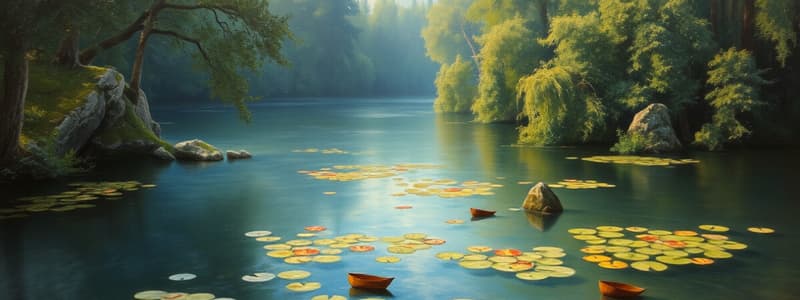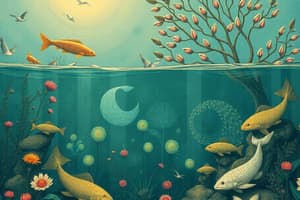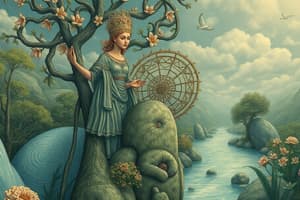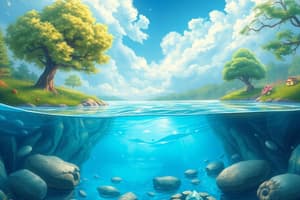Podcast
Questions and Answers
What process describes the release of water vapor from plant leaves?
What process describes the release of water vapor from plant leaves?
- Evaporation
- Infiltration
- Condensation
- Transpiration (correct)
What term is used for the combined process of evaporation from surfaces and transpiration from plants?
What term is used for the combined process of evaporation from surfaces and transpiration from plants?
- Condensation
- Infiltration
- Precipitation
- Evapotranspiration (correct)
Which of the following processes occurs first in the water cycle after water vapor rises and cools?
Which of the following processes occurs first in the water cycle after water vapor rises and cools?
- Runoff
- Precipitation
- Condensation (correct)
- Infiltration
Which statement best describes groundwater?
Which statement best describes groundwater?
In the carbon cycle, what is the primary form of carbon found in the atmosphere?
In the carbon cycle, what is the primary form of carbon found in the atmosphere?
What role do organisms play in recycling carbon?
What role do organisms play in recycling carbon?
How does carbon not enter the biogeochemical cycle?
How does carbon not enter the biogeochemical cycle?
What occurs to carbon dioxide when ocean water cools?
What occurs to carbon dioxide when ocean water cools?
Which of the following is a major reservoir for stored carbon?
Which of the following is a major reservoir for stored carbon?
What happens when fossil fuels are burned?
What happens when fossil fuels are burned?
What term is used to describe part of a cycle that holds an element or water for a short period of time?
What term is used to describe part of a cycle that holds an element or water for a short period of time?
Which of the following processes is NOT part of how water changes to gas?
Which of the following processes is NOT part of how water changes to gas?
Which statement accurately describes a reservoir in the context of the water cycle?
Which statement accurately describes a reservoir in the context of the water cycle?
Where does the water that our cells need ultimately originate from?
Where does the water that our cells need ultimately originate from?
Which state of water is NOT part of the water cycle?
Which state of water is NOT part of the water cycle?
What is the main factor driving the evaporation of water into vapor?
What is the main factor driving the evaporation of water into vapor?
What role do abiotic factors play in ecosystems regarding water?
What role do abiotic factors play in ecosystems regarding water?
What is the primary reason why water in the atmosphere is considered an exchange pool?
What is the primary reason why water in the atmosphere is considered an exchange pool?
During sublimation, what change occurs to ice and snow?
During sublimation, what change occurs to ice and snow?
What can be inferred about the water cycle based on the information provided?
What can be inferred about the water cycle based on the information provided?
Water molecules can be held in the atmosphere for just a few decades.
Water molecules can be held in the atmosphere for just a few decades.
The ocean is considered a reservoir for water, where it can be stored for thousands of years.
The ocean is considered a reservoir for water, where it can be stored for thousands of years.
Sublimation is the process where ice and snow directly change into water vapor due to low temperatures.
Sublimation is the process where ice and snow directly change into water vapor due to low temperatures.
The water cycle involves water in three states: gas, liquid, and solid.
The water cycle involves water in three states: gas, liquid, and solid.
Matter, including water, is lost as it passes through an ecosystem.
Matter, including water, is lost as it passes through an ecosystem.
Transpiration involves the uptake of water vapor through tiny leaf pores called stomata.
Transpiration involves the uptake of water vapor through tiny leaf pores called stomata.
Condensation occurs when water vapor changes into liquid water, forming clouds.
Condensation occurs when water vapor changes into liquid water, forming clouds.
Most precipitation that falls on land eventually becomes groundwater through a process known as evaporation.
Most precipitation that falls on land eventually becomes groundwater through a process known as evaporation.
Burning fossil fuels releases carbon dioxide into the atmosphere, increasing its levels.
Burning fossil fuels releases carbon dioxide into the atmosphere, increasing its levels.
Carbon in the atmosphere is found primarily as carbon monoxide (CO) rather than carbon dioxide (CO2).
Carbon in the atmosphere is found primarily as carbon monoxide (CO) rather than carbon dioxide (CO2).
Flashcards are hidden until you start studying
Study Notes
Water Cycle
- Water and chemical elements are recycled through biogeochemical cycles involving biotic (living) and abiotic (non-living) factors.
- Water can be old, with some molecules existing for millions of years, continuously moving through the cycle.
- Water exists in three states: gas (vapor), liquid, and solid (ice), undergoing various processes to change states.
Water State Changes
- Evaporation: Water transforms from liquid to vapor due to heat from the sun.
- Sublimation: Ice and snow convert directly to vapor also driven by solar heat.
- Transpiration: Plants release vapor through stomata, contributing to evapotranspiration alongside evaporation from the land.
- Condensation: Water vapor cools, forming droplets that may create clouds. Larger droplets eventually fall as precipitation.
- Precipitation Types: Includes rain, snow, sleet, and hail.
Water Flow and Storage
- Runoff: Water that flows over land after precipitation, eventually entering bodies of water.
- Infiltration: Water that soaks into the ground, becoming groundwater.
- Aquifers: Underground layers that store water, potentially for thousands of years.
- Ice masses and glaciers can store frozen water for prolonged periods.
Carbon Cycle
- Carbon is recycled through different processes involving living organisms and the atmosphere, essential for the creation of organic compounds.
- Major carbon reservoirs include the atmosphere, ocean, sedimentary rocks, and fossil fuels.
- Carbon exists in various forms: carbon dioxide (CO2), carbonic acid (H2CO3), bicarbonate ions, organic compounds, and other carbon-based substances.
Carbon Exchange Processes
- Carbon dioxide is released through cellular respiration in organisms and decomposition of organic material.
- Photosynthesis removes carbon dioxide from the atmosphere, converting it into organic compounds.
- Human activities, such as burning fossil fuels and deforestation, significantly increase atmospheric carbon dioxide levels.
- Geological processes like sedimentation slowly cycle carbon, storing it in rocks for millions of years.
Human Impact on Carbon Cycle
- Increased carbon dioxide concentrations today are higher than in the past hundreds of thousands of years, largely due to industrial activities.
- Land clearing reduces autotrophs that absorb CO2, while burning land also releases previously stored carbon.
Water Cycle
- Water and chemical elements are recycled through biogeochemical cycles involving biotic (living) and abiotic (non-living) factors.
- Water can be old, with some molecules existing for millions of years, continuously moving through the cycle.
- Water exists in three states: gas (vapor), liquid, and solid (ice), undergoing various processes to change states.
Water State Changes
- Evaporation: Water transforms from liquid to vapor due to heat from the sun.
- Sublimation: Ice and snow convert directly to vapor also driven by solar heat.
- Transpiration: Plants release vapor through stomata, contributing to evapotranspiration alongside evaporation from the land.
- Condensation: Water vapor cools, forming droplets that may create clouds. Larger droplets eventually fall as precipitation.
- Precipitation Types: Includes rain, snow, sleet, and hail.
Water Flow and Storage
- Runoff: Water that flows over land after precipitation, eventually entering bodies of water.
- Infiltration: Water that soaks into the ground, becoming groundwater.
- Aquifers: Underground layers that store water, potentially for thousands of years.
- Ice masses and glaciers can store frozen water for prolonged periods.
Carbon Cycle
- Carbon is recycled through different processes involving living organisms and the atmosphere, essential for the creation of organic compounds.
- Major carbon reservoirs include the atmosphere, ocean, sedimentary rocks, and fossil fuels.
- Carbon exists in various forms: carbon dioxide (CO2), carbonic acid (H2CO3), bicarbonate ions, organic compounds, and other carbon-based substances.
Carbon Exchange Processes
- Carbon dioxide is released through cellular respiration in organisms and decomposition of organic material.
- Photosynthesis removes carbon dioxide from the atmosphere, converting it into organic compounds.
- Human activities, such as burning fossil fuels and deforestation, significantly increase atmospheric carbon dioxide levels.
- Geological processes like sedimentation slowly cycle carbon, storing it in rocks for millions of years.
Human Impact on Carbon Cycle
- Increased carbon dioxide concentrations today are higher than in the past hundreds of thousands of years, largely due to industrial activities.
- Land clearing reduces autotrophs that absorb CO2, while burning land also releases previously stored carbon.
Studying That Suits You
Use AI to generate personalized quizzes and flashcards to suit your learning preferences.




